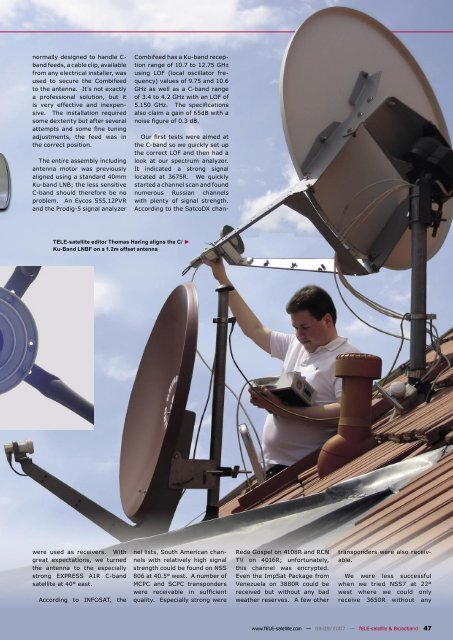Small&Solid - TELE-satellite International Magazine
Small&Solid - TELE-satellite International Magazine
Small&Solid - TELE-satellite International Magazine
Create successful ePaper yourself
Turn your PDF publications into a flip-book with our unique Google optimized e-Paper software.
normally designed to handle Cband<br />
feeds, a cable clip, available<br />
from any electrical installer, was<br />
used to secure the Combifeed<br />
to the antenna. It’s not exactly<br />
a professional solution, but it<br />
is very effective and inexpensive.<br />
The installation required<br />
some dexterity but after several<br />
attempts and some fine tuning<br />
adjustments, the feed was in<br />
the correct position.<br />
The entire assembly including<br />
antenna motor was previously<br />
aligned using a standard 40mm<br />
Ku-band LNB; the less sensitive<br />
C-band should therefore be no<br />
problem. An Eycos S55.12PVR<br />
and the Prodig-5 signal analyzer<br />
<strong>TELE</strong>-<strong>satellite</strong> editor Thomas Haring aligns the C/<br />
Ku-Band LNBF on a 1.2m offset antenna<br />
were used as receivers. With<br />
great expectations, we turned<br />
the antenna to the especially<br />
strong EXPRESS A1R C-band<br />
<strong>satellite</strong> at 40° east.<br />
According to INFOSAT, the<br />
Combifeed has a Ku-band reception<br />
range of 10.7 to 12.75 GHz<br />
using LOF (local oscillator frequency)<br />
values of 9.75 and 10.6<br />
GHz as well as a C-band range<br />
of 3.4 to 4.2 GHz with an LOF of<br />
5.150 GHz. The specifications<br />
also claim a gain of 65dB with a<br />
noise figure of 0.3 dB.<br />
Our first tests were aimed at<br />
the C-band so we quickly set up<br />
the correct LOF and then had a<br />
look at our spectrum analyzer.<br />
It indicated a strong signal<br />
located at 3675R. We quickly<br />
started a channel scan and found<br />
numerous Russian channels<br />
with plenty of signal strength.<br />
According to the SatcoDX chan-<br />
▲<br />
nel lists, South American channels<br />
with relatively high signal<br />
strength could be found on NSS<br />
806 at 40.5° west. A number of<br />
MCPC and SCPC transponders<br />
were receivable in sufficient<br />
quality. Especially strong were<br />
Rede Gospel on 4108R and RCN<br />
TV on 4016R; unfortunately,<br />
this channel was encrypted.<br />
Even the ImpSat Package from<br />
Venezuela on 3880R could be<br />
received but without any bad<br />
weather reserves. A few other<br />
transponders were also receivable.<br />
We were less successful<br />
when we tried NSS7 at 22°<br />
west where we could only<br />
receive 3650R without any<br />
www.<strong>TELE</strong>-<strong>satellite</strong>.com — 08-09/2007 — <strong>TELE</strong>-<strong>satellite</strong> & Broadband<br />
47

















